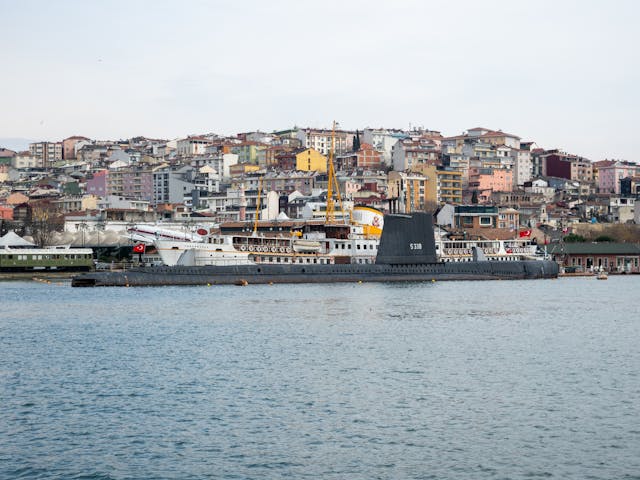
How do people breathe on a submarine? Submarines can carry a pressurized air supply, but most modern submarines make oxygen through a process called electrolysis.
Producing enough oxygen for all of the people on a submarine isn’t the only thing to consider when trying to keep them alive. The air we breathe is 78 percent nitrogen and 21 percent oxygen, with the last percent made up of mostly argon. Nitrogen and argon are both inert gases and they go in and out of our bodies without reacting with anything. Oxygen is extremely reactive and any more than 21 percent of it can lead to oxygen toxicity, which is very dangerous. The oxygen producing equipment on the submarine has to make sure the mix of gases is correct. Then there is the problem that we use the oxygen in our bodies and produce carbon dioxide as a byproduct. We breathe out all of the oxygen we don’t use and about 4.5% of carbon dioxide. That can quickly build up and a submarine needs to remove it so people don’t suffocate.
So, submarines need to keep the percentages of gas in the air and remove the carbon dioxide. On modern submarines, there are computers and sensors that measure the percentages of gas in the air. The computer will release more oxygen whenever it is necessary. The computer doesn’t have to do anything with the nitrogen and argon because they will not change. When the submarine is sealed to begin its journey, it is full of air from the surface. That air has nitrogen and argon, the levels of which never change, no matter how long the journey is, because we don’t do anything with it in our bodies.
The oxygen is made through a process called electrolysis. Submarines are surrounded by a substance that contains lots of oxygen. This is, of course, water. Fish are able to get at that oxygen, but we are not. That is where electrolysis comes in. It is the process of splitting the oxygen atom from the two hydrogen atoms in each water molecule. The first step is to remove the salt from the seawater surrounding the submarine. This also has to be done so that the crew have a source of drinking water. Submarines have desalination plants that take in water and heat it to boiling point. The water turns to steam and the steam rises up to be collected in pipes. The steam cannot carry the salt and that is left behind. The now salt free steam is cooled and becomes pure water. Some of this water is diverted to the electrolysis plant. An electrolysis plant works on the principle that water is a very stable molecule, but if you apply enough energy to it, you can break the molecule apart. The electrolysis plant has a negatively charged cathode and a positively charged anode. When enough electricity is sent into the water, the hydrogen and oxygen atoms separate. The hydrogen atoms are positively charged and they are attracted to the negatively charged cathode and the negatively charged oxygen atoms are attracted to the positively charged anode. The gases can then be collected. The hydrogen is either stored or released from the submarine. The oxygen is stored and released into the crew compartment.
Submarines also have emergency oxygen supplies as well. A certain amount of oxygen from electrolysis will be stored, but just in case this isn’t enough, they have oxygen candles as well. These are candles made of sodium chlorate and iron powder. When they are ignited, they produce sodium chloride, iron oxide, and oxygen. They burn at about 600℃, so they have to be insulated. Depending on their size, they produce about 28 liters of oxygen per minute. We breathe roughly 0.21 liters of oxygen per minute.
The next problem is the carbon dioxide. This is removed by something called a CO2 scrubber. These contain soda lime, which is sodium hydroxide and calcium hydroxide. When soda lime comes into contact with carbon dioxide, they react and the carbon dioxide is trapped. The reaction produces calcium carbonate, which is found in limestone, and water. One problem with these scrubbers is that they have to be replaced when they are full. These days, modern submarines use regenerative scrubbers that can release the trapped carbon dioxide and be reused. The released carbon dioxide would be stored or vented.
One problem with all of these systems, plus when we breathe, is that water is released. If you have ever slept in a tent, you know that just breathing can cause condensation to form. This is a problem that submarines have to deal with because too much condensation can destroy instruments. Submarines have to be fitted with pretty powerful dehumidifiers to absorb all of the water. And this is what I learned today.
Sources
https://en.wikipedia.org/wiki/Carbon_dioxide_scrubber
https://analoxgroup.com/blog/how-do-you-breath-onboard-submarine
https://en.wikipedia.org/wiki/Chemical_oxygen_generator
https://science.howstuffworks.com/transport/engines-equipment/submarine2.htm
https://as-scan.com/info/the-as-scan-blog/what-is-an-electrolyzer
https://en.wikipedia.org/wiki/Electrolysis_of_water
https://stargatehydrogen.com/blog/basics-of-hydrogen-electrolysis
Photo by Rasul Yarichev 🇦🇪: https://www.pexels.com/photo/ferry-in-a-harbor-in-istanbul-19063556/
